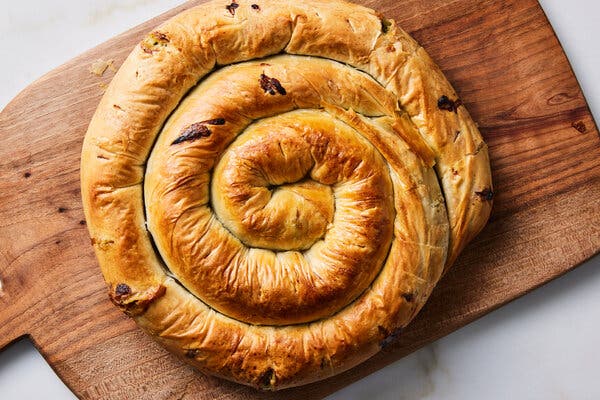A welcome addition to the Greek Orthodox table at Easter, striftopites get their extra-satisfying bite from a high phyllo-to-filling ratio.
Lovers of Greek phyllo pies know that pleasure can hinge on a crust’s ample surface area — but the key to maximizing this? A spiral.
A standard slice of phyllo pie offers a soft filling blanketed by flaky, tender, delightfully oily crust on the bottom, top and maybe — if luck delivers an edge or corner piece — a side or two. But a spiraled pie lavishes its admirers with perfectly proportioned bites, each with a satisfying ratio of phyllo to filling.
The golden spirals known as striftopites (the collective name for “twisted pies”) will appear on many lunch tables across Greece on Orthodox Easter — this year, on May 5 — alongside the compulsory sweet tsoureki loaves and platters of spit-roasted lamb, ending 40 days of Lenten fasting. (In the Greek Orthodox tradition, that means abstaining from products derived from red-blooded animals. For some of the strictest observers, that even includes olive oil, which was historically transported in goat-skin containers.)
Recipe: Spiraled Spanakopita With Feta
To make a striftopita, a cook spreads a savory or sweet filling onto thin dough, which is rolled into a loose log, then coaxed into a ruched spiral. The pie is usually baked — sometimes fried — for a crisp exterior that yields to tender filling. Lots of olive oil or, less often, butter is involved. The crevices between rings allow fat to penetrate the dough, adding flavor and flakiness. And in sweet pies, those gaps provide a path for the pastry to evenly absorb the sugary syrup.
Phyllo pies, spiraled or otherwise, arrived in northern Greece when the Greek Orthodox population left Turkey under the Treaty of Lausanne, said Anastasia Miari, who has traveled across Greece documenting traditional recipes, many of which are included in her cookbook, “Yiayia: Time-Perfected Recipes and Stories from Greece’s Grandmothers.” The spirals of layered dough remain common beyond the country’s borders, including Bulgaria’s banitsa, Turkey’s börek and Moldova’s invartita.
“Phyllo pies,” Ms. Miari said, “are the Greeks’ version of sandwiches,” similarly featuring regional variations, a range of sizes and a plurality of fillings.
Pies on the Greek islands tend to be more compact than on the mainland because of a historical scarcity of firewood, said the cookbook author Aglaia Kremezi, who lives on the island of Kea. The smaller the pie, the quicker it cooks.
In Greece, cheese is the most common filling — often feta combined with another type. Spinach and mixed greens are also popular, often supplemented with bulgur, raisins, green onions, leeks or cheeses. Where wild greens and fennel fronds are not an option, Ms. Kremezi recommends complementing store-bought spinach (fresh or frozen) with flavorful bitter greens like arugula, chard, beet greens, or chicory, and adding a big bunch of flat-leaf parsley.
But what is nonnegotiable for avid home cooks in Greece is good phyllo, always made with flour and water, and sometimes with olive oil, lemon juice or spirits. Taming raw dough with a verga, the long, thin rolling pin used for phyllo, takes time to master — perhaps “a lifetime,” Ms. Miari said, and it bears little resemblance to the commercial stuff that is often thin and brittle enough to shatter with the touch of a fork’s tine.
The first time Ms. Kremezi made a pie for her husband-to-be, using store-bought phyllo, he pushed aside the crust and ate only the filling. “It tastes like cardboard,” she recalled him saying of the bland casing. To enhance commercial phyllo’s flavor, she suggests brushing the pie with egg wash or yogurt before baking. (A fresh-phyllo pie would simply be brushed with more oil or butter.)
The Cypriot chef Marilena Joannides has made it her mission to dispel the aura of difficulty that surrounds phyllo-making. Using just a stand mixer and a small hand-cranked pasta roller, she tries to show home cooks in her classes that making fresh phyllo is easier than they might imagine.
An easier solution still, and evidence of striftopites’ popularity among Greeks, lies inside a vast expanse of display freezers at Mediterranean Foods, a Greek supermarket in Astoria, Queens. On a recent visit, the sounds of Greek talk radio and Greek chatter among cashiers and customers greeted shoppers who could choose from an expanse of display freezers devoted to imported spiraled pies, with fillings including a range of cheeses, spinach, pumpkin with raisins and walnuts, and apple with cinnamon. If all else fails, they are ready to bake.
